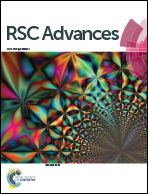Imidazolium chloride immobilized on copper acetylacetonate-grafted magnetic chitosan as a new metal/ionic liquid bifunctional catalyst for selective oxidation of benzyl alcohols in water
Abstract
Copper acetylacetonate and 1-methyl-3-propylimidazolium chloride as an ionic liquid (Fe3O4/CS/Cu/IL) were immobilized on chitosan magnetite nanoparticles via covalent attachment. The prepared heterogeneous catalyst was characterized by Fourier transform infrared spectroscopy (FT-IR), scanning electron microscopy (SEM), X-ray powder detection (XRD), thermogravimetric/differential thermal analyses (TG/DTA), vibrating sample magnetometry (VSM), inductively coupled plasma atomic emission spectroscopy (ICP-AES) and energy dispersive X-ray (EDX) spectroscopy. The Fe3O4/CS/Cu/IL exhibits superior catalytic activity for the oxidation of various benzyl alcohols to the corresponding carboxylic acids using TBHP as an oxidant. The catalyst could be simply recycled with the assistance of an external magnet and reused for five runs without significant loss of activity.


 Please wait while we load your content...
Please wait while we load your content...